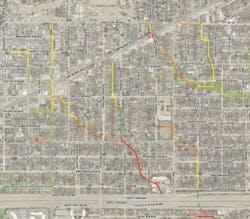About the author: Elizabeth Young, GISP, is IT manager for the city of Fort Worth’s Transportation Public Works Department. Young can be reached at [email protected].
The city of Fort Worth, Texas, created a storm water utility in 2006 to address concerns over drainage issues and flooding throughout the city. One of its first major initiatives was to gain an understanding of the assets it owned and where they were located. Since then, the city has identified more than 100,000 assets, including pipes, inlets, channels, infalls, outfalls, manholes, flumes and drains, that it is responsible for maintaining. Knowing where assets are located has helped Fort Worth become more proactive in maintaining assets, conduct thorough flooding studies and better plan for future work.
Like most municipalities, Fort Worth is faced with the issue of aging infrastructure and limited resources. Once city officials knew where the assets were located, the city needed a way to understand which assets were critical so it could better focus its resources on those most likely to cause issues.
Implementing a Plan
The city of Fort Worth Stormwater Management Div. realized the next step in understanding its assets was to identify which assets were critical to the system. With the assistance of Woolpert Inc., the city conducted a criticality assessment to analyze and identify which assets had the greatest business risk exposure (BRE).
Workshops were held with city engineers and key maintenance personnel to determine various factors that influenced the probability of failure (PoF) and consequence of failure (CoF) for each asset type. The city chose to focus on pipes, inlets, manholes, drains and infalls. Criteria such as asset age, material, capacity, type and operating environment were used to define an asset’s PoF. CoF factors focused primarily on the financial impact or health and safety costs that might occur because of an asset failure.
The city chose to utilize available information such as asset size, depth, proximity to buildings and roadways, and public facilities (such as fire stations, police stations, hospitals or schools) the asset serves.
“Identifying that our assets have separable factors has increased awareness of how each factor may need to be approached differently, so that in the future we are likely to have different approaches for preventive actions when dealing with high failure potential versus high failure consequences,” said Steve Eubanks, senior professional engineer for the city of Fort Worth.
Geographic information system (GIS) personnel within the Stormwater Management Div. analyzed various GIS information to develop PoF and CoF values for all major assets. They spent many hours working with engineers to ensure the information generated in the analysis made logical sense, often trying various ways to get at the information so it truly showed which assets were the most at risk.
Once the analysis was completed, the information was reviewed by the same team that helped create the factors to ensure everything fell in line with what field personnel believed was currently happening in the field. The process then was documented in detail so it was repeatable and defendable.
Fort Worth plans to refine the criticality analysis annually, generating new BRE scores each year based on new information incorporated from survey work, condition assessments conducted in the field and completed capital projects.
Utilizing the Final Product
The final result was a BRE score for each asset. Because each asset has a score, the information can be tied to a GIS and produce a visual representation of how various neighborhoods might be impacted or which parts of town need additional attention. The goal is to use these scores throughout the city’s everyday business to help make better decisions and justify the need for funding.
Fort Worth’s first project is to conduct condition assessments on many of the city’s underground pipes. Using the BRE scores, the city will target areas at the highest risk. The data collected in the assessment will be used to fine-tune the criticality scores. The BRE scores also can be used to prioritize capital projects.
Mary Hanna, professional engineer for the city of Fort Worth, said Fort Worth “plans to use the criticality results to assist us in prioritizing future projects and planning efforts. The results of the criticality will help us identify high-priority areas to concentrate on first to make the best use of limited storm water funding.”
In addition to using the BRE scores for capital project planning needs, Fort Worth hopes to utilize the scores to prioritize maintenance work inside its work order system.
“We know where many of our problem areas are based on past incidents such as local flooding, cave-ins and citizen calls,” Eubanks said. “What the criticality assessment provides is identification of other similar areas that need attention before a cave-in, localized storm or unhappy citizen brings them to our attention in a negative way.”
Download: Here


